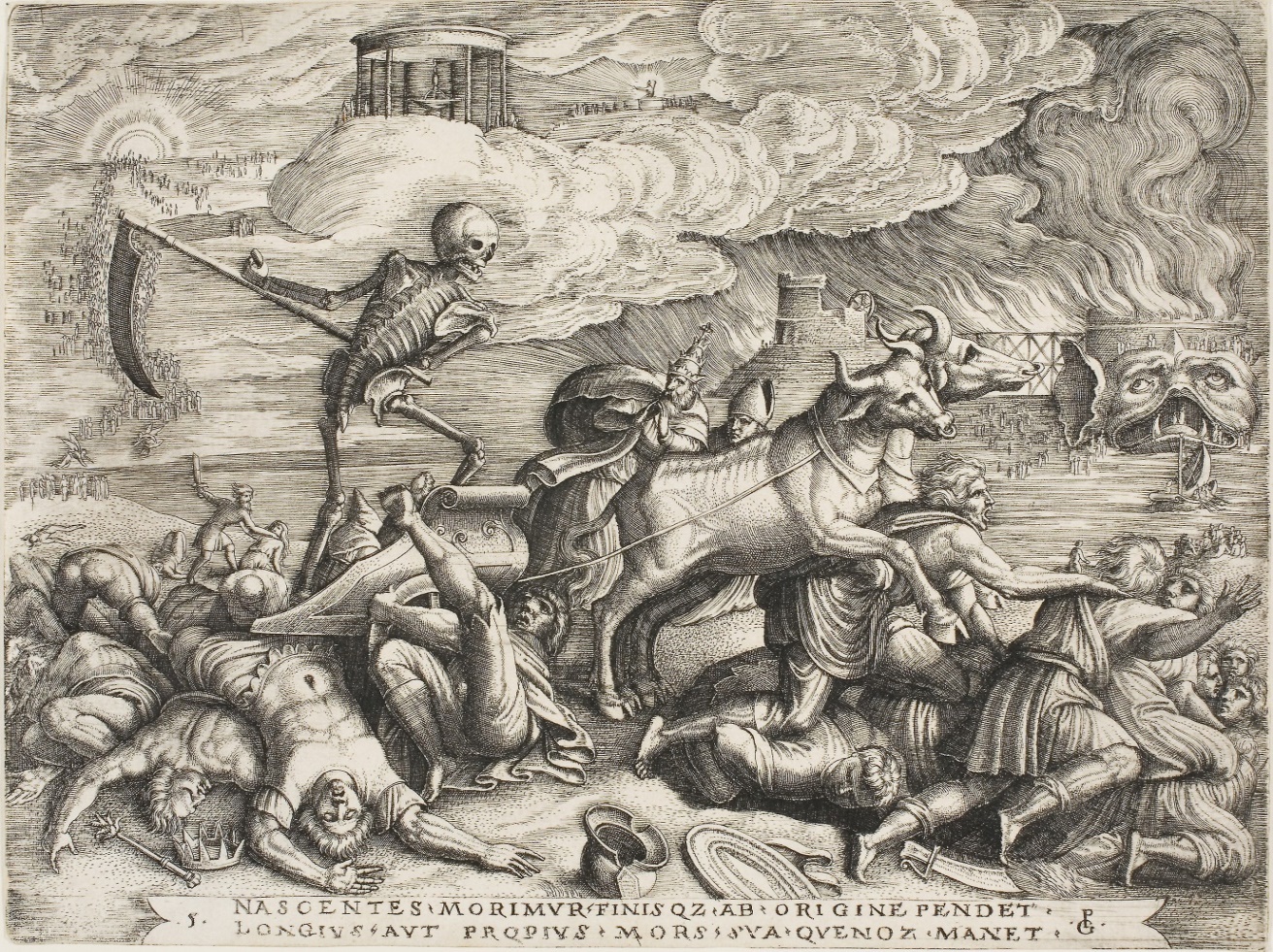The long, harrowing months of the COVID-19 pandemic have set the world in a constant state of panic. Suddenly, people seem to have grown more conscious of their pending demise, being almost convinced that they are more likely to die of the virus than any other cause. Admittedly, the past year has been the loneliest for many people globally. One advantage of solitude is that it persuades an individual to retrospect on many issues. Likewise, it motivates one to notice and appreciate things, such as Georg Pencz’s Triumph of Death, a relic of an ancient plague, which would otherwise be overlooked. A thoughtful reflection on the Triumph of Death reveals that pestilences metaphorically represent expiration, which is an inevitable, but unanticipated human fate.
The image below, represented as figure 1, shows Pencz’s Triumph of Death, created in 1539. It depicts a scythe-wielding human skeleton riding an ox-drawn chariot. According to the Minneapolis Institute of Art (MIA), the frame represents Death as it annihilates popes, bishops, and kings with spite and a tremendous force those nobody can escape. Those who are yet to be crashed appear hypnotized by the sheer dreadfulness of their impending demise. Additionally, a terrifying Hellmouth opens in the distant right corner. On the left background, a multitude appears in procession toward an opening to great light, most probably, the sun. At the bottom of the painting are Latin words stating that people begin dying as soon as they are born, implying that the beginning and the end are connected. The writing further holds that death is already waiting and will eventually devour each person.

Triumph of Death depicts a deadly outbreak that catches the royalty and the religious leaders, thus causing their mass death. Pencz’s painting is a reminiscence of plague, a constant life threat in Europe during the medieval period. The fact that corpses are piling up over one another, and the living seems cornered and unable to escape, signifies an element of surprise. According to Camus (18), historical records prove that there have been as many pestilences as wars, but both equally keep startling people. He further argues that most people, being humanists, engage in deceitful thoughts of immortality, consequently failing to take precautions in the event of an outbreak. The elite dying in masses, as the painting shows, confirms that society hardly confronts the problematic concepts of dying, including its acknowledgement. The artwork depicts a thoughtful reflection over the meaning of the plague’s surprising nature, possibly hinting that life is a prison.
Inability to escape the impending death is also conceivable as Pencz’s suggestion that every human is a prisoner. The king awaits the approaching skeleton with a load of treasures, hoping to pay away his damnation. Nonetheless, the scythe is going to strike, possibly killing him, along with the pope, in one ruthless swipe. Likewise, those who are still seemingly distant from Death do not attempt to flee. Like prisoners on death row, they are resigned, only with no likelihood of clemency. An outbreak attracts responses that characteristically limit freedom, thereby isolating members of the affected area. For example, the most immediate measures against coronavirus spread involved social distancing and protective face covering. When the pandemic blew out of proportions, quarantine, lockdown, and curfew measures were implemented, effectively alienating the loved ones and halting the rhythm of life. Death, whether its cause is a plague, accident, or other fellow humans’ actions, holds people hostage.
Pencz went beyond the façade of pestilence to reveal the significance of suffering. The tormenting death that the characters in Pencz’s painting endure forces one to question why people suffer and whether they deserve it. The religious angle that the artwork takes –including the Pope and insinuations of life after death – arguably implies that God permits Death to torment people as retribution for being sinful. However, Camus loathes this perspective as he shows an innocent child suffer and succumb to the bubonic plague (Camus 103). The random distribution of suffering convinces that nobody deserves it and life is, at best, absurd. Even the justice systems that specialize in punishing law offenders can hardly justify misery beyond one layer. For instance, if a single mother of two children breaks the law, she may deserve punishment, but the negative consequences inevitably flowing to her innocent babies instigate a moral dilemma.
Pencz’s Triumph of Death is a classic artwork that accurately predicts the future. It gains its timeless relevance from Pencz’s ability to understand the fundamental element of epidemics. All the greatest pestilences known to humanity have always killed many people in one location. Even though COVID-19 seems to be a burden to the present generation, adopting a new perspective will help people adjust and live with it. The advantage of knowing that a person will die should motivate them to work without hope of despair to lessen the underserved yet random suffering humans face. By appreciating the Triumph of Death, people may cast aside the destructive humanist belief that compels them to disbelieve pestilences or assume that they are immune to an outbreak and instead take precautionary measures to promote survival.
References
Camus, Albert. The Plague. Translated by Stuart Gilbert. Penguin Books, 1966.
Pencz, Georg. Triumph of Death. Painting. 1539. Minneapolis Institute of Art. Minneapolis Institute of Art. Web.
